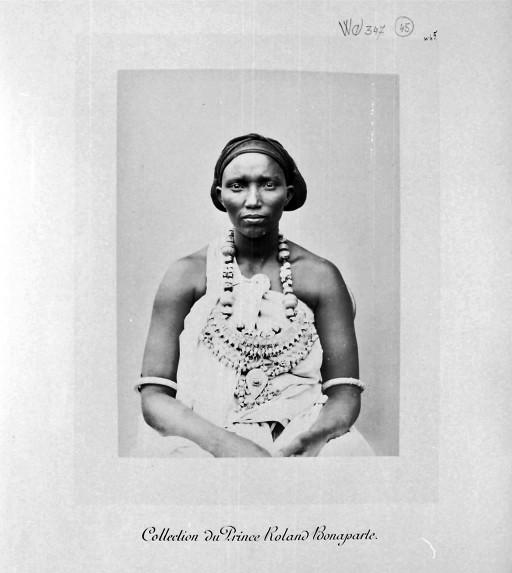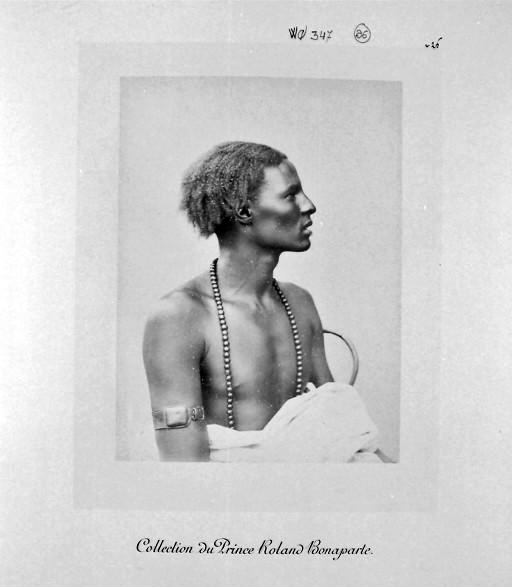
D uring the past few weeks the Parisians can see the Jardin d'Acclimation an ethnographic exhibition more curious: it is a caravan of twenty-six Somali men, women and children. Through the kindness of well-known Mr. Geoffroy Saint-Hilaire, we were able to examine closely and in detail the samples of a human race we do not often get to see in Paris. The description we give here, is written from the invariable plane that we set for our ethnographic descriptions.

Colonial Exposition of 1907 in Nogent sur Marne
the country. -All Somalis from the Zoo come from this part of the African coast which lies exactly in-dess [o] us of Aden, they belong to the tribes Habr-Auel, Habr-Junise, Habr-Gerhadjis, Habr- Toldjaleh, Dolbohanta, etc.. But the Somalis in general, occupy a much larger territory, because they are spread over the entire surface of the north-eastern Africa, that affects one side to the Gulf of Aden, and the other in the Indian Ocean.
the north, they go to Abyssinia to the south, they extend to the territory of the Sultan of Zanzibar to the west, the country is poorly known, the limits are undecided. Moreover, the Somalis are constantly at war with the Galla, their neighbors on this side.
The region inhabited by our Somalis can be divided into three parts: 1 the coast, where there are few large villages and are given the names of cities, 2 ° a long chain of limestone mountains that run along the first zone ; 3 the interior plateau, crowned by high mountains, where nomads live. We can say generally that the country is little rain.
Currently, countries are Somalis in the Protectorate of England, which has some posts in the main coastal towns.

"A Somali woman [sic] and child, past visitors to the Zoo in Paris."
(Based on a snapshot of Mr. Maurice Bucquet, 1890)
(Based on a snapshot of Mr. Maurice Bucquet, 1890)
Man. -The inhabitants of the Somali region are given themselves the name of Somalis, some authors, for reasons quite questionable philological, want to write Comalies. Somalis tell they are from Saudi. We find among them two very distinct types, which were observed by the ancient Egyptians. The first would be similar to that of people say Cushites, while the other, without being truly negro belongs to a type more or less Negroid. This dual origin of Somali populations, which explains the variations in color of the skin, which is observed on individuals of the Zoo. The skin color varies Indeed, since the tone light chocolate to a dark tone black enough.
The second of these types is characterized by a smooth forehead, rounded and oblique, nostrils dilated and massive, thick lips, a receding chin. These few characters tend to bring this type of negroes, but he moves away, however, by the whole face. As to the first type, it has, instead, a high forehead and right, a little upper jaw undershot, nose slightly aquiline and fine. The cheekbones are not very visible, the lips are of medium thickness. The profile of this type has many similarities with that of Bedjahs of Nubia.
Women are often affected by steatopygia.

Tarrach Aden, 20, Habr Jounis tribe, Ayal Ishac.
Photo taken in the garden of acclimatization, 1890
Photo taken in the garden of acclimatization, 1890
Power. - The food of the people of the coast consists mainly of rice, dates, moutama. Nomads tend to live on milk and livestock. For long trips, they take calabashes, containing pieces of mutton roasted, drowned in melted butter. They eat gazelles, but never birds. Au Jardin d'Acclimation, they want to kill themselves sheep for use in food. They are generally very greedy. They drink milk and water, never spirituous liquors. Nomads procure fire by rubbing two sticks against each other. Cooking utensils are fairly coarse, they are vases muck without ornaments, spoons and dishes are made of wood.

Mohamed Balla, tribe Habr Anel M'Chahil, 25.
Photo taken in the garden of acclimatization, 1890
Photo taken in the garden of acclimatization, 1890
Home. - The Somali homes consist of "gourguis", made of mats and skins they are portable. On the coast, there are more spacious cabins, they are square and contain several parts. The furniture of these cabins is a wooden stool or a bed consisting of uprights supporting a chassis strings.
Handoulla Abdi tribe Toumal (blacksmith) Ambour, 20.
Photo taken in the garden of acclimatization, 1890
Photo taken in the garden of acclimatization, 1890
Clothing. -. The costume of both sexes is fairly complicated, it is draped in a cloth. Women's staple on the left shoulder, sometimes leaving one breast uncovered. They form a kind of skirt is girding for a belt.
The shoe is a kind of sandal. Nomads have the same costume, it is only skin. Neck they wear a small leather pouch containing a prayer from the Koran. As ornaments, the women wear earrings, necklaces, bracelets, elbows and wrists. Their hair is locked in a headdress. The children have their heads partially shaved, except two strips of hair that intersect at right angles to the top of the head. The Somalis involved a lot of her hair. Plus it's long, reddish, more the owner is proud. The red color is achieved by using lime water.
The weapons are: the small round shield made of antelope skin, mace and spears they project both off with great force. Nomads over an arc with which they throw poison darts and sling. On the coast they have a few guns.
The weapons are: the small round shield made of antelope skin, mace and spears they project both off with great force. Nomads over an arc with which they throw poison darts and sling. On the coast they have a few guns.

Dahabo Hersi, Habf Toldjalé tribe, 24.
Photo taken in the garden of acclimatization, 1890
Photo taken in the garden of acclimatization, 1890
Agriculture .- Cultures do not exist, it is, "said Mr. Révoil, both natives of laziness incarnate, and the nature of lack of ground soil.

Ahmed Hersi, Habr Jounis tribe, Ayal Ishac, 13.
Photo taken in the garden of acclimatization, 1890
Photo taken in the garden of acclimatization, 1890
moral character. -The hospitality is given between natives, especially on the coast, quite generously. Theft and robbery, and boldly exercised, have something worthwhile for the Somalis. As a token of friendship, they shake hands. The oath is often used, but they attach no importance, except in the case of "vendetta" that one, it is held.
The Somalis do not have musical instruments, dancing, they are accompanied by the voice and hands.
Islamism is the only religion of the Somalis. They are very superstitious. However, there are many legends that prevail among them, it comes to snakes, which sometimes said to be continuing thieves until they abandoned the stolen items.

Gahha Aman, Habr Anel, Moussa Isa, 2 years.
Photo taken in the garden of acclimatization, 1890
Photo taken in the garden of acclimatization, 1890
Social Institutions. - Young Somalis can not marry before the age of 15 years only the rich have several wives, but they can be only under the same roof. The divorce is done often enough, the woman then becomes completely free to act.
Women do not wear veil as Arabs. The dead are buried according to Muslim ritual: the body is sewn into a shroud of skin or cloth, it is carried to the mosque where they say the customary prayers and is then driven into the ground.

Ismail Omar tribe Habr Jounis Abdallah Ishac, 2 years.
Photo taken in the garden of acclimatization, 1890
Photo taken in the garden of acclimatization, 1890
In social terms, the Somalis are divided into three classes: the first is the rich owner, the second that of the Bedouins, and finally that of last Midgan. The slaves are few.
Such, in broad outline, the description of the Somali people living in a country so awful and so sorry that Mr. Révoil characterizes it by saying that "the only field that is cultivated, is the field of the dead. "
Prince Roland Bonaparte (1854-1928): Somalis in the Zoological Gardens of Paris ,
in Nature, 1890, pp. 247-250
in Nature, 1890, pp. 247-250


0 comments:
Post a Comment